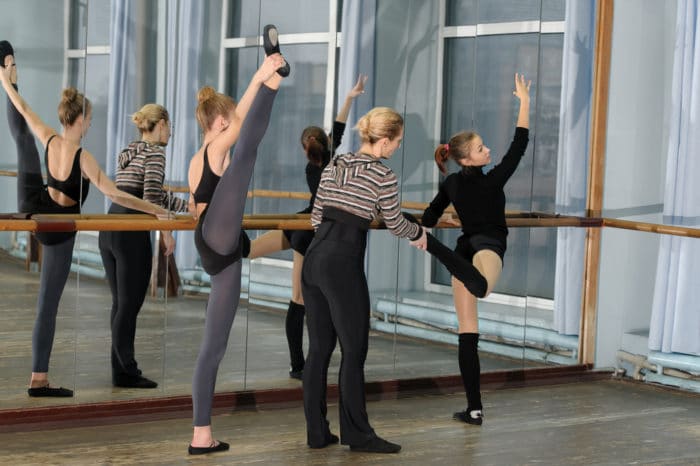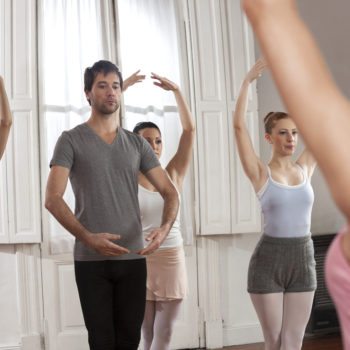Why We Love It
-
$51,560Potential Avg. Salary
-
5.6%Job Growth Rate
-
Growing DemandJob Outlook
-
Fast Paced CareerCareer Attribute
A choreographer is an experienced dancer who creates performances, expresses feelings and ideas through bodily movement at different contexts, whether it’s a dance school or on stage.
Recommended Schools
What is a Choreographer?
Duties
When you take on a job as choreographer, you will be responsible for completing the following tasks:
- Create sequential moves for dances or reinterpret existing dances in accompaniment to a dance routine.
- Run auditions for dancers to star in a show or join a dance company.
- Collaborate and work closely with other instructors, choreographers, and other dancers to modify and enhance dance performances.
- Take part and attend a range of promotional events like photography sessions for stage productions you will appear in.
- Provide inputs on performance elements like costume design, lighting, and stage designs for performances.
Day In The Life
Choreographers have a jam-packed schedule that revolves around choreographing and running rehearsals for upcoming performances. Much of the day is spent by editing and updating dance routines as per best practices and their entertainment value for judges or audience members. These changes and tweaks can take weeks or months as it requires dedication directing practice sessions among dancers, arranging and re-arranging choreography and slowly perfecting the dance.
It is the choreographer’s responsibility to ensure that the performance is pleasurable for participants themselves but also makes an impact on those watching it. In the case of choreographers working with celebrities or the film industry, they work closely with actors and singers to help them express their characters’ movements better or develop a signature visual style.
Work Schedule
Your work schedule will vary based on the type of work you are doing. When it comes to tours, you may have long irregular workdays due to intense rehearsals and late night performances. If you are employed by a dance school, you will have standard workweek hours and spend your time instructing students on dance. Some also work part time at theme parks, casinos or cruise ships. In this profession, you will often spend hours thinking creatively and brainstorming new dance routines for your class or a scheduled stage performance.
Growth Of The Job
Job opportunities for dancers are expected to grow around 5% between 2014-2024, the average rate for most occupations. The growth rate for jobs in the choreography industry is also projected to increase by 6% during 2014 to 2024. The demand for experienced and well-trained choreographers will primarily result from increasing enrollment in dance schools.
This field sees fierce competition with the number of job openings insufficient to provide for interested candidates. With enough experience, dancers are promoted to a dance captain in a theatre, or a ballet master or mistress at stage companies. Choreographers often exercise their creative talent as film, theatre or television producers and directors.
Typical Employers
With growing interest in various dance forms through pop-culture, many fields apart from dance schools, such as movies, theme parks, dance competitions and casinos are expected to provide greater exposure to choreographers. Some will also work as dance teachers at various levels of expertise, whether at a college, high school or elementary school – provided they possess a college degree. However, the degree requirement is sometimes waived at dance studios or conservatories due to adequate work experience. As an example, around half of dancers and choreographers were employed by schools and performing arts companies in 2014.
Recommended Schools
How To Become a Choreographer
The majority of choreographers begin their career as dancers, and get a deep insight into dance routines. Dancers start training at an early age between 5 and 8 for girls, a little later for boys. A professional dance company is a good place to kick-start your career with part-time and full-time training programs for all ages.
Educational institutions also offer academic programs for dance such as a bachelor’s degree or master’s degree in dance, typically under the department of theater or fine arts. Such programs allow you to specialize in different dance styles such as jazz, hip-hop, modern, ballet. Previous formal training will allow you to succeed in your professional career.
To excel in this career path, you must have superior physical strength, dexterity and balance to craft visually pleasing and artistic dance routines. Directing a group of dancers to perfect dance routines also requires a strong commitment to the field and well-rounded leadership skills. Dancing takes a toll on your body so be prepared to handle the physical demands of your work.
Choreographer Salary Data
We’ve provided you the following to learn more about this career. The salary and growth data on this page comes from recently published Bureau of Labor Statistics data while the recommendations and editorial content are based on our research.
National Anual Salary
Low Range
$28,980Average
$51,560High Range
$95,100National Hourly Wage
Low Range
$14/hrAverage
$25/hrHigh Range
$46/hrHow do Choreographer salaries stack up to other jobs across the country? Based on the latest jobs data nationwide, Choreographer's can make an average annual salary of $51,560, or $25 per hour. This makes it an Above Average Salary. On the lower end, they can make $28,980 or $14 per hour, perhaps when just starting out or based on the state you live in.
Salary Rankings And Facts
#370 Nationally for All Careers
Programs and Degrees
Here are the most common degrees for becoming a Choreographer. a is usually recommended and specifically a degree or coursework that prepares you for the particular field, see below.
Highest Education Among Choreographers
- 0.5% Doctorate
- 4.3% Masters
- 17% Bachelors
- 10.6% Associates
- 29% College
- 26.7% High School
- 11.9% Less than High School
Job Growth Projections and Forecast
2014 Total Jobs
7,1002024 Est. Jobs
7,500Job Growth Rate
5.6%Est. New Jobs
400How does Choreographer job growth stack up to other jobs across the country? By 2024, there will be a change of 400 jobs for a total of 7,500 people employed in the career nationwide. This is a 5.6% change in growth over the next ten years, giving the career a growth rate nationwide of Below Average.
Growth Rankings And Facts
#399 Nationally for All Careers
What Companies Employ The Most Choreographers
| Industry | Current Jobs | New Jobs Needed | % Increase |
|---|---|---|---|
| Other schools and instruction; private | 4,500 | 400 | 0% |
| Self-employed workers | 1,100 | --- | --- |
| Colleges, universities, and professional schools; private | 100 | --- | --- |














